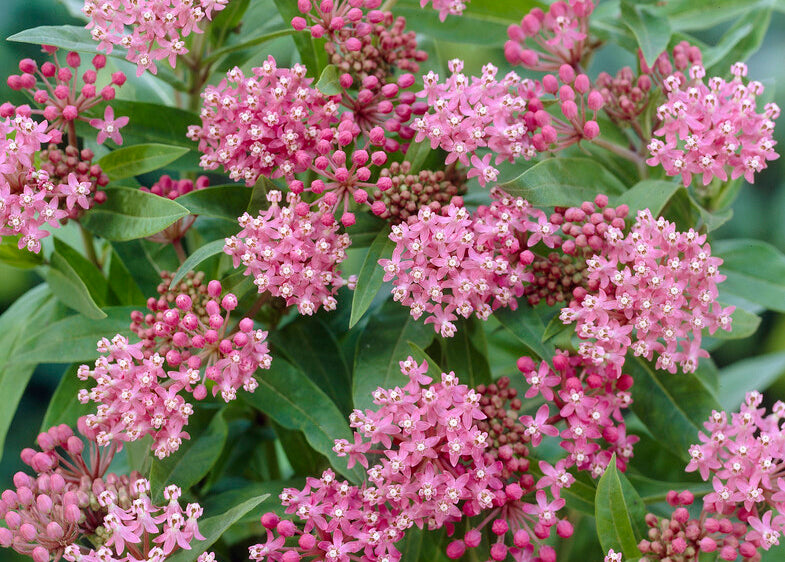Offering understated beauty, near-effortless maintenance, and huge ecological benefits, the charming Swamp Milkweed is a must-grow perennial for wildflower enthusiasts, butterfly lovers, and novice gardeners alike!
What is Swamp Milkweed?
Asclepias incarnata, better known as Swamp Milkweed is a flowering, herbaceous perennial which takes its name from the milky sap that exudes from its stems if they are broken. Swamp Milkweeds are moisture lovers, growing wild throughout the swamps, wetlands, stream banks, and riverbeds of North America. Its root systems have adapted to thrive in moist, low-oxygen environments where most terrestrial plants would struggle to survive.
Reaching anywhere between three and six feet tall, each upright stem is crowned with a dense spray of delicate pink or white blossoms all throughout summer. Milkweeds are the wildlife lovers' dream, enticing a plethora of pollinators who feast on its nectar-rich flowers. Plants in the Milkweed genus are especially beloved by many species of butterfly, not least the magnificent Monarch butterfly. Milkweeds are the only plant on which the Monarch butterfly lays her eggs. The emerging caterpillars will then feast voraciously on the Milkweed foliage before transforming into breathtaking adults. Planting just a few Milkweeds will soon transform your garden into a booming butterfly paradise!
The genus name Asclepias honors Aesculapius, the Greek God of Medicine, in recognition of the Milkweeds' medicinal properties. For over a thousand years, all parts of the plant, from roots to petals, have been used by herbalists to create multifunctional, miracle salves. Milkweed has been used to treat anything and everything from wounds to burns, toothaches to headaches, and cancer to leprosy!
And it’s not just in medicine that Milkweed has proved to be worth its weight in gold. Its tough and durable stem fibers have long been used to make rope, twine, and heavy-duty fabrics. Its parachute-like seedpods were even used to stuff lifejackets during World War Two! The seedpods are six times more buoyant than cork (and lighter of course)!
Caring for Swamp Milkweed
Getting Started
We currently offer two stunning varieties of Swamp Milkweed sold as dormant bare-root plants. The ‘Soulmate’ features classic dusky pink blooms, while the ‘Ice Ballet’ offers charming sprays of elegant off-white blossoms. Aim to plant them in spring or early fall when the ground is cool but not frozen. Milkweed grows very slowly at first, but once the soil warms up you'll soon notice a flurry of new shoots and buds emerging.
Dig a hole twice as wide as the root ball, and just deep enough that the crown of the roots lies flush with the soil's surface. Young Milkweeds should be watered regularly but lightly for their first year until their roots are well established.
Pots and Positioning
Once established, Milkweeds will spread via their underground rhizomes, so give them plenty of space in the border, around 30 inches in all directions. If growing yours in pots, select a container that will be stable enough to support their tall stems once matured, and plenty wide enough to accommodate their spreading root systems.
Soil
When it comes to soil for Swamp Milkweed, the wetter the better. Avoid loose, sandy soil as it will drain too quickly. Mulching regularly around the base of the plants will help the soil retain much-needed moisture. Neutral to slightly acidic soil is ideal, but not essential. It's notoriously tricky to grow ornamentals in heavy, wet, or low-quality soils. For unlucky gardeners with wet clay or nutrient-poor soil, Swamp Milkweed is the answer to your prayers!
Light
Swamp Milkweeds will grow taller and bloom more abundantly in full sun positions, but they will adapt reasonably well to partially shaded conditions too.
Water
Regular, deep waterings are essential for happy Milkweeds. Try to recreate the naturally moist wetland conditions of Milkweed's natural habitat and never allow the soil to dry out completely. If you notice leaves dropping in summer, it probably means they need a drink.
Temperature and Humidity
Swamp Milkweed will thrive almost anywhere in hardiness zones 3 through 9. And of course, these water babies love high humidity, so grow them close to ponds, water features, or soggy places in the garden.
Fertilizer
To promote strong growth, you can add a little phosphate fertilizer whilst flowering, but this isn’t essential, as Milkweeds flourish in nutrient-poor conditions.
Pruning
Unruly Milkweeds can be neatened up and pruned into submission in the fall, but they won’t need regular pruning or deadheading.
Overwintering
As fall arrives, your Milkweed will begin to lose its foliage. Cut the stems right back to ground level to them conserve energy over winter. Gardeners in hardiness zones three and above needn’t make any special provisions over winter, but those in colder zones should apply a generous layer of mulch in late fall to insulate the roots from harsh frosts.
Pests and Disease
The milky sap secreted by Milkweed contains latex which is a natural insect repellant! This means Swamp Milkweed isn’t particularly pest-prone, but keep an eye out for aphids and beetles who may munch on the foliage.
As with any plant grown in wet conditions, fungal diseases are a possibility. Giving your milkweeds plenty of space in the border to encourage air circulation should prevent diseases from taking hold.
Top Tips
Milkweeds have deep taproots which don’t like being disturbed once settled, so make sure you’re happy with their intended position before you commit to planting them.
Swamp Milkweed will self-seed prolifically in the fall. Its seed pods are encased in parachute-like membranes, helping them to travel long distances around your garden and beyond. If you’d prefer not to have lots of new Milkweeds popping up around your garden come spring, it's best to remove the seed pods in early fall before they take flight!




